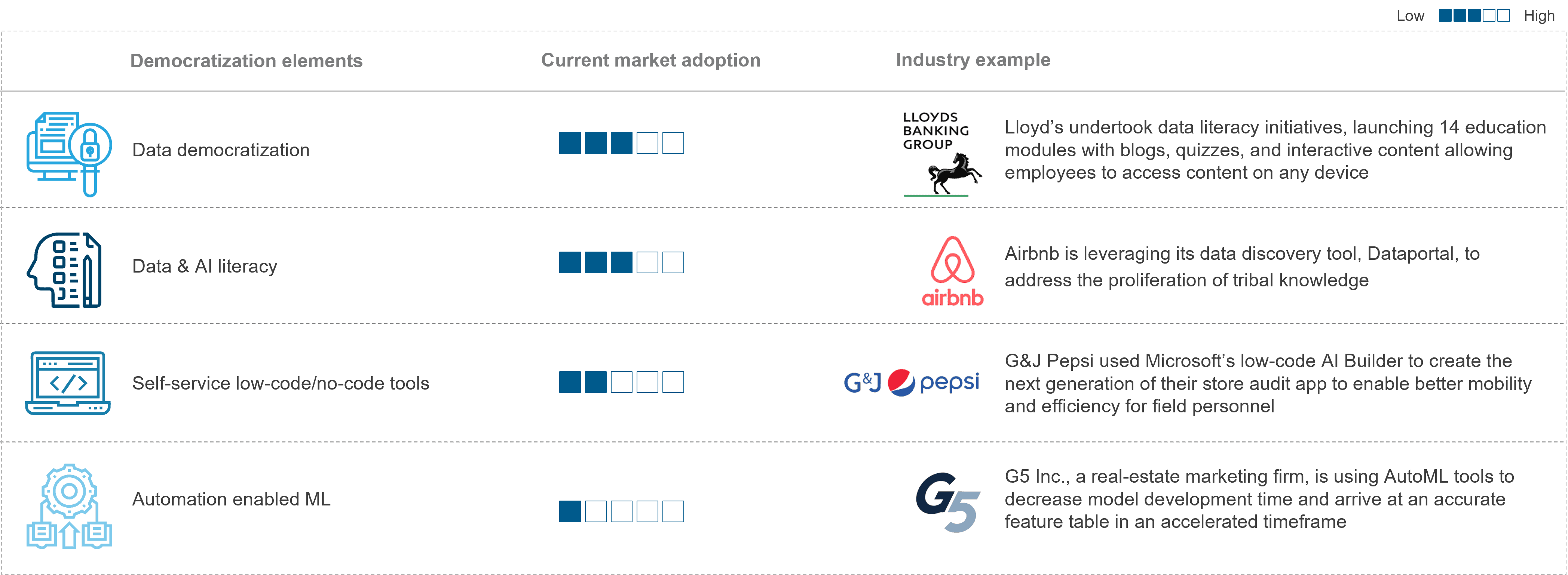Blog
Democratization: Artificial Intelligence for the People and by the People

Enterprises have identified Artificial Intelligence (AI) as a quintessential enabling technology in the success of digital transformation initiatives to further increase operational efficiency, improve employee productivity, and deliver enhanced stakeholder experience. According to our recent research, Artificial Intelligence (AI) Services – State of the Market Report 2021 | Scale the AI Summit Through Democratization, more than 72 percent of enterprises have embarked on their AI journey. This increased AI adoption is leading us into an era of industrialization of AI.
Talent is the biggest impediment in scaling AI
Enterprises face many challenges in their AI adoption journey, including rising concerns of privacy, lack of proven Return on Investment (RoI) for AI initiatives, increasing need for explainability, and an extreme crunch for skilled AI talent. According to Everest Group’s recent assessment of the AI services market, 43 percent of the enterprises identified limited availability of skilled, mature, and niche AI talent as one of the biggest challenges they face in scaling their AI initiatives.

Enterprises face this talent crunch in using both the open-source ecosystem and hyperscalers’ AI platforms for the reasons below:
- High demand for open-source source machine learning libraries such as TensorFlow, scikit-learn, and Keras due to their ability to let users leverage transfer learning
- Low project readiness of certified talent across platforms such as SAP Leonardo, Salesforce Einstein, Amazon SageMaker, Azure Machine Learning, and Microsoft Cognitive Services due to lack of domain knowledge and industry contextualization
As per our research in the talent readiness assessment, a large demand-supply gap exists for AI technologies (approximately 25 to 30 percent), hindering an enterprise’s ability to attract and retain talent.
In addition to this technical talent crunch, another aspect where enterprises struggle to find the right talent is the non-technical facet of AI that includes roles such as AI ethicists, behavioral scientists, and cognitive linguists.
As more and more enterprises adopt AI, this talent challenge becomes more exacerbated at the same time the demand for AI technologies is skyrocketing. There is an ongoing tussle for AI talent between academic, big tech, and enterprises, and, so far, the big techs are coming out on top. They have been able to successfully recruit huge amounts of AI talent, leaving a drying pool for the rest of the enterprises to fish in.
Democratization to overcome the talent problem
We see democratization as a potential solution to overcome this expanding talent gap. As we define it, democratization is primarily concerned with making AI accessible to a wider set of users targeted specifically at non-technical business users. The principle behind the concept of democratization is “AI for all.”
Democratization has to do with educating business users in the basic concepts of data and AI and giving them access to the data and tools that can help build a larger database of AI use-cases, develop insights, and find AI-based solutions to their problems.
Enterprises can leverage Everest Group’s four-step democratization framework to help address talent gaps within the enterprise and empower its employees. Here are the steps to guide a successful democratization initiative:
- Data democratization: The first step of AI democratization is enabling data access to business users throughout the organization. This will help familiarize them with the data structures and interpret and analyze the data
- Data and AI literacy: The next step is embracing initiatives to help business users build general knowledge of AI, understand the implications of AI systems, and successfully interact with them
- Self-service low-code/no-code tools: Organizations should also invest in tools that provide pre-built components and building blocks in a drag and drop fashion to help business users deploy ML models without having to write extensive code
- Automation-enabled machine learning (ML): Lastly, enterprises should use automated machine learning (AutoML) for automating ML workflows that involve some or all of the steps involved in the model training process, such as feature engineering, feature selection, algorithm selection, and hyperparameter optimization
Following these steps, democratization can help reduce the barriers to entry for AI experimentation, accelerate enterprise-wide adoption, and speed up in-house innovation among its benefits.
Current state of democratization
The industry as a whole is now in the initial stages of AI democratization, which is heavily focused on data and AI literacy initiatives. Some of the more technologically advanced or well-versed enterprises have been early adopters. The exhibit below presents the current market adoption of the four key elements of democratization and a few industry examples:

Democratization is essential
As part of their democratization efforts, enterprises must also focus on contextualization, change management, and governance to ensure responsible and successful democratization.
By doing this, companies will not only help solve the persistent AI talent crunch but also ensure faster time to market, empower business users, and increase employee productivity. Hence, democratization is an essential step to ensuring the sustainable, inclusive, and responsible adoption of AI.
What have you experienced in your democratization journey? Please share your thoughts with us at [email protected] or at [email protected].